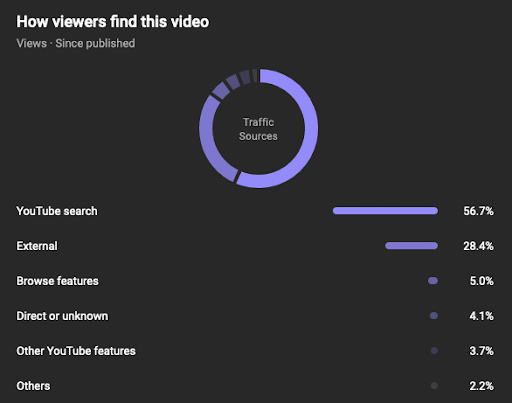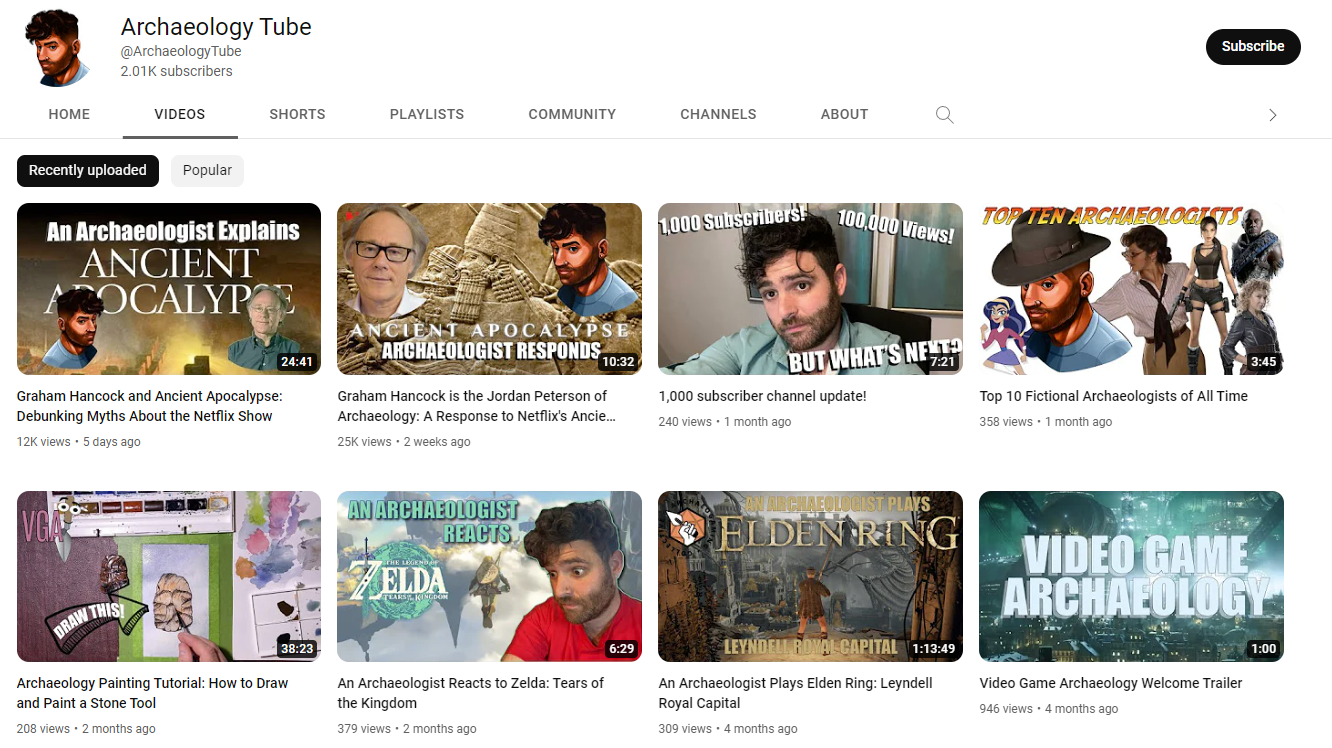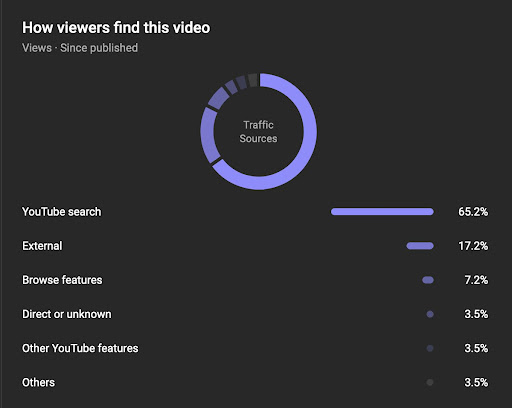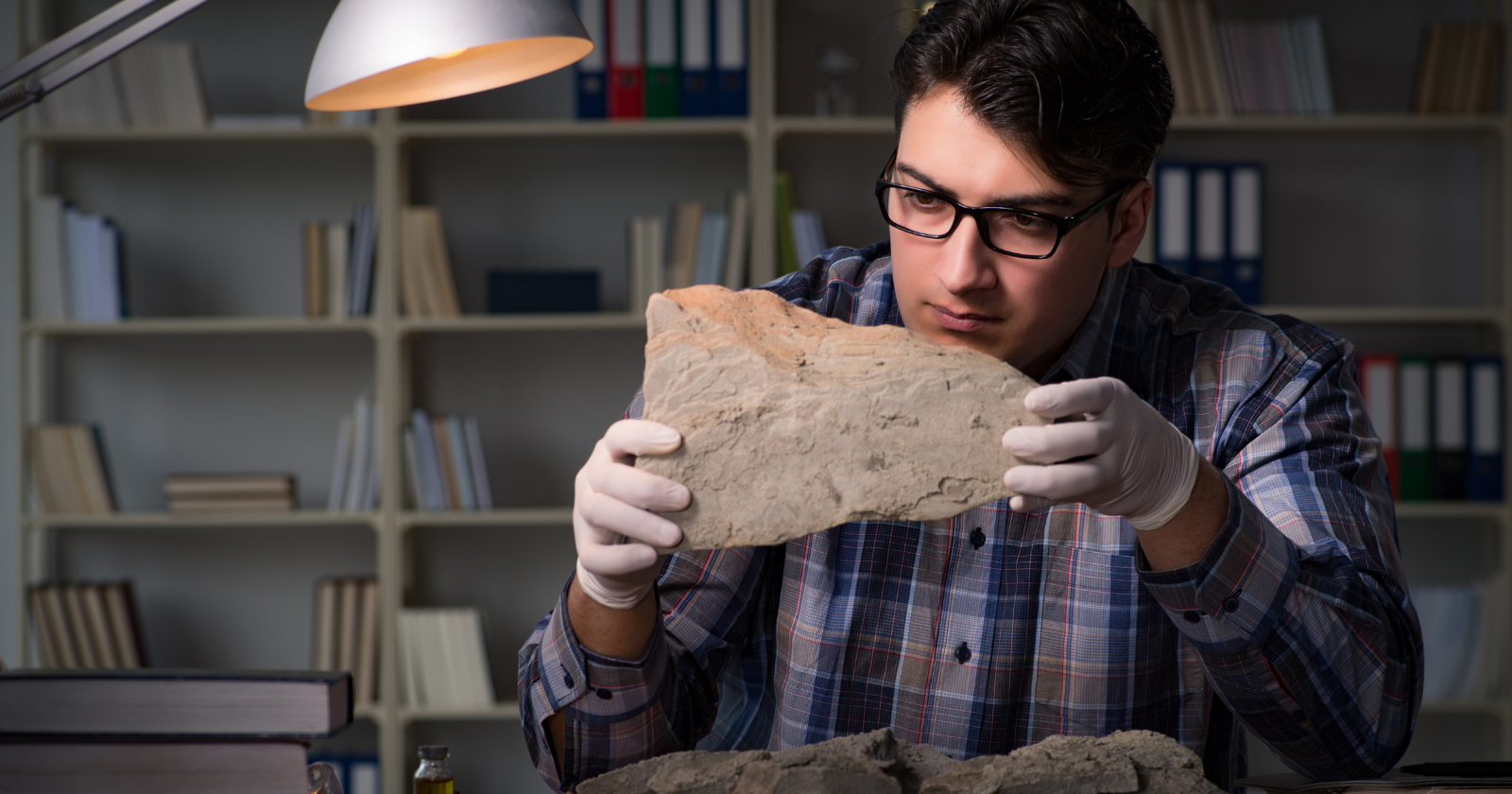The opinions expressed within this story are solely the author’s and do not reflect the opinions and beliefs of Search Engine Journal or its affiliates.
You may have heard about “Ancient Apocalypse”, a series in which host Graham Hancock proposes controversial theories about the origins of ancient civilizations.
It spent a week trending in the global top 10 on Netflix, accruing around 24,620,000 watch hours between November 14th and November 20th, 2022.
Netflix lends authority to the show by categorizing it as a “docuseries,” and IMDB classifies it as a “documentary” and “history.”
But online, it’s been shrouded in controversy, and search algorithms might be rewarding good-faith critiques about the show from scientists and educators – as some working archaeologists have deemed the show unsubstantiated pseudoscience at best, and dangerous misinformation at worst.
The Society For American Archaeology wrote a letter to Netflix asking it to reclassify and contextualize the show, citing the host’s “aggressive rhetoric,” the show’s “false claims,” and the associations that the theories presented have with “racist, white supremacist ideologies.”
But this is a story about the role SEO plays in the controversy – how scientists and science communicators present their critiques of the show, and how audiences find them.
Search algorithms get a lot of critiques for how they can be used to spread misinformation.
But in this case, I’ve seen support for educators and scientists who have committed to pushing back on popular pseudoscience.
Creators Rebutting “Ancient Apocalypse” Get A Boost From SEO
I first learned of the controversy from YouTube creator “History With Kayleigh,” who, while not an academic or accredited archaeologist, creates educational videos about ancient history and archaeological sites.
She interacted with Tweets from scientists who had responded and “decided to try and write a fair rebuttal to the show,” as she told me.
Kayleigh’s video about “Ancient Apocalypse” isn’t the best-performing video on her channel. Still, it was definitely performing above the average of her recent releases in a short amount of time, at 67,000 views on December 1st.
 Screenshot from YouTube, December 2022
Screenshot from YouTube, December 2022But then, I took another screenshot of the channel after the weekend, on December 5th.
Kayleigh released a second video, and the first “Ancient Apocalypse: Fact Or Fiction?” had already grown to 104,000 views.
 Screenshot from YouTube, December 2022
Screenshot from YouTube, December 2022Kayleigh wasn’t the only creator to publish content about the Netflix series.
Dr. Bill Farley, an archaeologist and associate professor at Southern Connecticut State University who runs a small YouTube channel about archaeology in his free time, made one of the earliest YouTube videos critiquing Hancock and the show.
And while his reach is much smaller, his videos about “Ancient Apocalypse” exploded.
 Screenshot from YouTube, December 2022
Screenshot from YouTube, December 2022 Screenshot from YouTube, December 2022
Screenshot from YouTube, December 2022Dr. Farley shared screenshots of his YouTube analytics, demonstrating that his first video about Graham Hancock drew more traffic than usual from Google searches.
The below screenshots are from November 22nd, when the video was still around 5,000 views.
For that particular video, the “external” traffic source was around 28%, compared to his channel average of around 10%. A third of that external traffic was from Google.
 Screenshot of internal analytics of the “Archaeology Tube” YouTube channel, November 2022
Screenshot of internal analytics of the “Archaeology Tube” YouTube channel, November 2022 Screenshot of internal analytics of the “Archaeology Tube” YouTube channel, November 2022
Screenshot of internal analytics of the “Archaeology Tube” YouTube channel, November 2022The following screenshot is the overall channel data for comparison.
 Screenshot of internal analytics of the “Archaeology Tube” YouTube channel, November 2022
Screenshot of internal analytics of the “Archaeology Tube” YouTube channel, November 2022He also shared the search terms the video was performing best for within YouTube search.
 Screenshot of internal analytics of the “Archaeology Tube” YouTube channel, November 2022
Screenshot of internal analytics of the “Archaeology Tube” YouTube channel, November 2022I checked in again with his channel on December 5th.
 Screenshot from YouTube, December 2022
Screenshot from YouTube, December 2022This first video still gains most of its traffic from search terms. External views on it were about 11% lower on December 5th than they were on November 22nd.
This makes sense with publications picking up the story and filling up search engine results pages (SERPs).
 Screenshot of internal analytics of the “Archaeology Tube” YouTube channel, November 2022
Screenshot of internal analytics of the “Archaeology Tube” YouTube channel, November 2022The second video has wildly different statistics, being pushed mostly by YouTube’s browse features like recommended videos.
 Screenshot of internal analytics of the “Archaeology Tube” YouTube channel, November 2022
Screenshot of internal analytics of the “Archaeology Tube” YouTube channel, November 2022This time, YouTube seems to have recognized the interest in a trending topic and pushed the video accordingly.
In the first video that he made about “Ancient Apocalypse,” Dr. Farley addressed Hancock directly with a critique focusing on the relationship between the theories posed in the show, and white supremacy.
In the second video, Dr. Farley focused on debunking the specific falsehoods in the show.
He told me, “There is a MARKED difference in the reactions to the two videos. In video #1, I mention white supremacy and the history of Atlantean myths with racism. That video has … hundreds of disparaging comments [that] are misogynistic, racist, and homophobic.
The second video also has some comments like this, but many more positive comments or constructive criticisms. This video just spoke directly to some of the falsehoods in the show but does not directly address racism or white supremacy.”
Even with the negative reaction, the fact remains that people watched and engaged with the video, as this screenshot of the video’s engagement statistics shows.
 Screenshot of internal analytics of the “Archaeology Tube” YouTube channel, November 2022
Screenshot of internal analytics of the “Archaeology Tube” YouTube channel, November 2022One could argue that this is a fluke – and that these seemingly successful performance metrics are simply about capitalizing on a trending keyword.
But YouTube algorithms work differently from Google Search.
YouTube uses metadata about videos to estimate relevance, but it also uses user engagement signals such as watch time to test the relevance of videos to particular queries. YouTube’s top ranking factor is viewer satisfaction.
“History with Kayleigh” has a large following already that likely gave her videos a boost. But Dr. Farley doesn’t have a large following, and the reach of his videos comes down to organic discovery.
People Search For Information About “Ancient Apocalypse” And Discover Critique
Other scientists, with small and large followings, have also seen unusually high traffic about this topic on other platforms.
Dr. Flint Dibble, an archaeologist at Cardiff University, wrote a rebuttal for The Conversation and noted the popularity of the piece on Twitter:
 Screenshot from Twitter, November 2022
Screenshot from Twitter, November 2022I reached out to Dr. Dibble for his perspective. He stated: “I’ve gotten a wide range of responses to my thread. Plenty of abuse, and plenty of praise. Several people clearly found it while searching for more info on the show.
Some, especially within the first week of release, mentioned they were searching Twitter to find reactions to it either before watching or mid-watch.
The people who mentioned finding the thread through a search were all glad for quickly getting a clearer context for the show.”
He shared an example of a Twitter user who went looking for information about the show while they were watching it and appreciated the critique he posted on the platform:
 Screenshot from Twitter, December 2022
Screenshot from Twitter, December 2022Dr. Andre Costopoulos, an archaeologist at the University Of Alberta, wrote about the show on his personal WordPress blog and shared his blog analytics with me in late November.
The content he wrote about “Ancient Apocalypse” became the best performing on his website in a matter of days, with Google Search making up the clear majority of traffic.
 Screenshot of internal analytics from archeothoughts.wordpress.com, November 2022
Screenshot of internal analytics from archeothoughts.wordpress.com, November 2022Overall, this isn’t a huge amount of traffic. What’s interesting here is how the content about the show compares to other content by this creator, especially because the site is relatively small.
Dr. Costopoulos believes that scientists can reach audiences hungry for information if they learn the tools.
“Scientists can use these tools just as well as our pseudo-alters,” he told me, “and often to better effect, because we actually have evidence to back up our claims.”
How SEO Can Be Used To Spread Misinformation
Search algorithms are hotbeds of misinformation.
Dissemination of conspiracies and misinformation has been a hot topic on many different platforms, from YouTube to Facebook.
Google has been reckoning with misinformation and how best to solve it for years.
People who peddle conspiracy theories and pseudoscience know this. They’re expert marketers and storytellers, and they’re good at SEO.
That can make it much more difficult to communicate good science than misinformation. Scientists have demanding jobs outside of marketing and publishing, and their conclusions are often difficult to communicate effectively.
They’re not trained to do it, and academia is slow to adapt to digital trends.
That paves the way for a conspiracy theory to take off with little more than a good story and good marketing.
Dr. Farley said: “By and large, I think academics have no idea how to do SEO (I’m just stumbling around in the dark myself), and misinformation folks are much, much better at it. Academics, frankly, don’t have the time to learn this stuff.
It would be really cool if our universities would help… but I’ve found the media departments at unis are very old school. If I brought this to them, they’d pitch a media statement to the local newspaper.
Our media department is great and has great intentions, but by and large, they’re early in the game on using social media as a media tool.”
So we have a conundrum where scientists, who aren’t necessarily trained in communications and marketing, face off against professional marketers of ideas. And they’re doing it with personal passion projects on top of their existing jobs.
When it comes to organic reach, scientists need allies.
Is Critique Of “Ancient Apocalypse” Having An Impact?
The results don’t seem as encouraging when you zoom out and take a look at the SERPs for “Ancient Apocalypse.”
I opened an incognito window in Chrome and made sure my VPN was turned on (United States location), then searched for [ancient apocalypse].
![Screenshot of Google search [ancient apocalypse]](https://www.searchenginejournal.com/wp-content/uploads/2022/12/2022-12-01-10-639a5bce38b01-sej.png) Screenshot from search for [ancient apocalypse], Google, December 2022
Screenshot from search for [ancient apocalypse], Google, December 2022The first result is just a link to the show. That’s to be expected.
Immediately below are the video results. The second video result appears to support the show. It had around 60,000 views when I took the screenshot. That’s a significant amount of reach compared to the examples we looked at above.
The third video result has much fewer views but critiques the show.
We can also see, on the information panel, that the critiques from the scientific community may not be having a widespread impact. Audiences review the show well.
Underneath the video results, we do see critiques from The Guardian and Slate. Let’s flip over to the news results.
![Screenshot of Google news results for [ancient apocalypse]](https://www.searchenginejournal.com/wp-content/uploads/2022/12/2022-12-01-12-639a5c120bdde-sej.png) Screenshot from search for [ancient apocalypse], Google, December 2022
Screenshot from search for [ancient apocalypse], Google, December 2022I checked in again a few days later, using an incognito guest Chrome browser with my VPN turned on (United States location). There was an interesting change in the SERP:
![Screenshot of Google search results for [ancient apocalypse]](https://www.searchenginejournal.com/wp-content/uploads/2022/12/2022-12-05-7-639a5c52eaf76-sej.png) Screenshot from search for [ancient apocalypse], Google, December 2022
Screenshot from search for [ancient apocalypse], Google, December 2022So, what’s the takeaway here?
Archaeologists Saw A Boost From SEO With Limited, But Important, Impact
Archaeologists did see a boost from SEO on this topic. But we can see from Google results that the show is popular, and the show’s supporters have a lot of traction too.
The limited effect of this collective effort demonstrates the hurdles facing science communicators. The impact of their critique seems to be a drop in the bucket compared to millions of people who watched the show.
But we shouldn’t discount the success of these scientists and educators, either.
They’re building communities, providing information for people who search for it, and changing minds. When you look closely, you can clearly search algorithms rewarding these creators for their efforts.
Interested users do discover legitimate scientific research when they look into the series. The content is reaching people, and it’s inspiring them to examine the show critically.
This is encouraging news for the overall quality of search.
I think marketers can help here.
SEO professionals have the knowledge and resources to help amplify these messages. Perhaps we could consider it a little bit of search community service.
More resources:
- Tips For Avoiding Misinformation In SEO Resources & Conversations
- Google on Penalizing Misinformation
- How To Identify Fake News From Real News Online
Featured Image: Elnur/Shutterstock





![AI Overviews: We Reverse-Engineered Them So You Don't Have To [+ What You Need To Do Next]](https://www.searchenginejournal.com/wp-content/uploads/2025/04/sidebar1x-455.png)